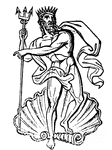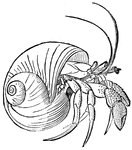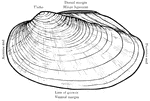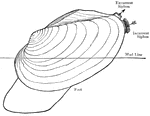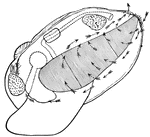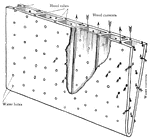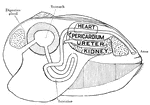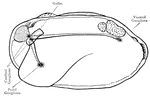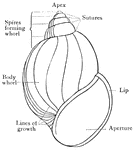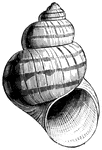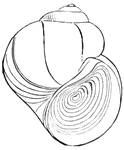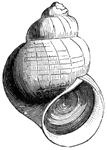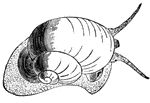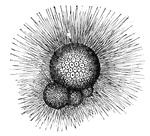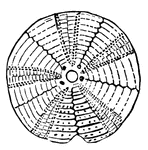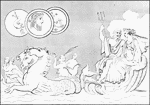
Poseidon and Amphitrite
Poseidon (god of the sea) and Amphitrite (queen of the sea) ride in a shell-shaped chariot pulled by…

Hermit Crab
When alarmed, the hermit crab withdraws itself wholly into its portable house, closing the mouth of…
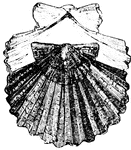
Scallop
Scallops are distinguished by the regular ribs of the shell, and by the two angular projections that…

Hawksbill turtle
The hawksbill turtle is on the endangered species list primarily due to commercialization of it shell.

Oystercatcher
Oyster-catchers are noisy birds. The bill is powerful for opening mussels, oysters and other shell-fish.
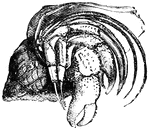
Hermit Crab
"When alarmed, the hermit crab withdraws itself wholly into its portable house, closing the mouth of…

Mandolin
The strings of the mandolin are not plucked by the fingers like a guitar or harp, but with a little…

Victoria Shell Body Sleigh
From a chart of "Late styles of fashionable carriages and sleighs," 1893.

Six-Passenger Shell Body Sleigh
From a chart of "Late styles of fashionable carriages and sleighs," 1893.
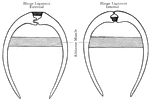
Clam Shell
Mechanism for opening and shutting a clam shell, note the internal and external hinge ligament..
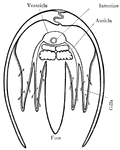
Clam
Cross section of the body of a clam, through the heart. Arrows indicate water current through the gills.
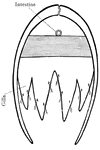
Clam
Cross section of the body of a clam, through the posterior adductor muscles. Arrows indicate water current…
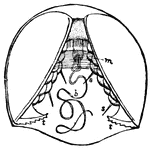
Clam
Young clam, still within the egg membrane. m, adductor muscle; t, hooks by which it attaches itself…
Razor Shell Clam
The razor shell clam has a shell somewhat resembling in shape and size the handle of a razor.
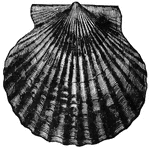
Scallop
Scallop; also known as the crusader's badge. While at rest the scallop lies on the bottom with its valves…

Slug
Slugs are air-breathing, terrestrial gastropods, almost always destitute of a shell. Slugs are nocturnal,…
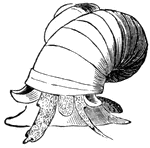
Pond Snail
A pond snail creeping. The largest part extending from the shell is the foot. The proboscis is in the…

Limpet
Limpets are found along the shore. they are gastropods with low conical shells. this is a surface view.
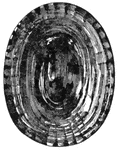
Limpet
Limpets are found along the shore. they are gastropods with low conical shells. This is a side view.
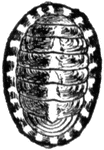
Chiton
Chiton is a peculiar marine mollusk. It is low and flat, creeping like the limpets. But the shell consists…
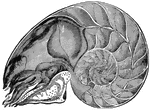
Nautilus
Chambered nautilus, showing chambers with soft body in outer chamber. It is closely related to the squids…
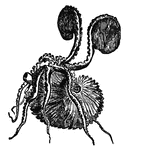
Paper Nautilus
The paper nautilus is closely related to the octopus. It creates its own thin shell, or egg case, in…

Paper Nautilus
The paper nautilus is closely related to the octopus. It creates its own thin shell, or egg case, in…

Foraminifera
Foraminifera are minute shelled animalcules. They secrete a hard covering or shell made of sand or carbonate…
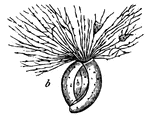
Foraminifera
Foraminifera are minute shelled animalcules. They secrete a hard covering or shell made of sand or carbonate…
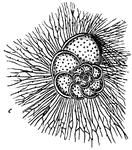
Foraminifera
Foraminifera are minute shelled animalcules. They secrete a hard covering or shell made of sand or carbonate…

Foraminifera
Foraminifera are minute shelled animalcules. They secrete a hard covering or shell made of sand or carbonate…
Foraminifera
Foraminifera are minute shelled animalcules. They secrete a hard covering or shell made of sand or carbonate…
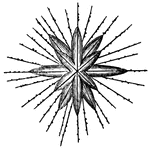
Polycystina
Polycystina are microscopic in size and possess a structureless sarcode-body, enclosed in a perforated…
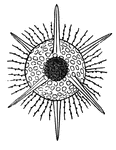
Polycystina
Polycystina are microscopic in size and possess a structureless sarcode-body, enclosed in a perforated…

Clam
Anatomy of a bivalve clam. (ss) respiratory tubes; (aa) muscles by which the shell is closed (b) gills;…

